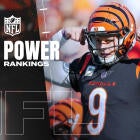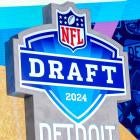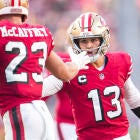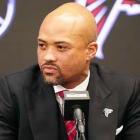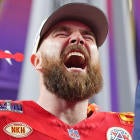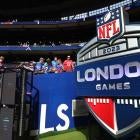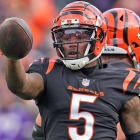After Alvin Kamara essentially came out of nowhere to win the Offensive Rookie of the Year in 2018, odds-on favorite Saquon Barkley took home the award last year.
Will there be another under-the-radar winner this season? Or will another Barkley-type favorite win it? Let's rank the likely Offensive Rookie of the Year candidates in 2019.
11. Andy Isabella, WR, Cardinals
Isabella was born to play in Kliff Kingsbury's Air Raid system, with vertical routes to accentuate his 4.31 speed, and a variety of quick screens to tap into his tremendous yards-after-the-catch talent. He somewhat miraculously tallied 102 receptions for nearly 1,700 yards with 13 touchdowns in 2018, despite well-below-average quarterback play at UMass as a senior.
There's going to be plenty of space for Isabella to operate in Arizona's spread offense, and the Cardinals are going to go really fast, which will lead to more opportunities for the speedy, shifty, and relatively nuanced pass-catcher. Kingsbury's Texas Tech offenses finished 4th, 9th, 2nd, and 3rd in offensive plays per game over the past four seasons among FBS teams, per TeamRankings.com. Isabella is likely going to be a big part of what the Cardinals do on offense.
However, he comes in at No. 10 on this list because Larry Fitzgerald is still around, second-year pro Christian Kirk played in an Air Raid system in college and is bound to get his fair share of targets, and the monstrous Hakeem Butler is in the mix too. Oh yeah, certainly can't forget about David Johnson either.
10. Miles Sanders, RB, Eagles
The talent is undeniably there with Sanders, a fluid, flexible, multi-faceted runner who sat behind Saquon Barkley for years at Penn State, then erupted as a senior. Running behind one of the league's best offensive lines will help Sanders' Rookie of the Year chances.
So will the fact that Carson Wentz is back, and the Eagles can seriously threaten teams with the pass at all levels of the field. But Sanders finds himself in a crowded backfield with Jordan Howard, Corey Clement, Wendell Smallwood, and Josh Adams. The latter three combined for 1,134 rushing yards on 275 carries (4.12 yards per) and 57 receptions for 480 yards (8.42 yards per). Sure, one of those backs will likely either be let go or simply not see many touches at all in 2019.
Then again, is Sanders likely to see the ball often near the goal line? Howard received 68.8% of Chicago's total team carries inside the 5-yard-line last season -- the eighth-highest figure in football -- and parlayed those 10 attempts into six touchdowns. Sanders is primed to be productive as a rookie. I just don't know if he'll get Offensive Rookie of the Year type volume in a deep running back committee with the Eagles.
9. Justice Hill, RB, Ravens
Like Sanders, Hill is in a loaded backfield with a club that added a proven veteran -- Mark Ingram -- this offseason. But the situations are not exactly identical. In Baltimore, Hill will carry the ball in one of the run-heaviest clubs in football as a rookie. Last year, the Ravens ran the ball on 47.7% of their offensive plays, the third-highest figure in the league.
In the final three games of the regular season, when Lamar Jackson had firmly become the starter, the Ravens ran it a whopping 54.6% of the time, per TeamRankings.com, easily the highest percentage in the NFL. Sure, Jackson will get his designed runs. So will Ingram, of course. Heck, even Gus Edwards and Kenneth Dixon together accumulated 1,051 yards on a just 197 carries (5.33 yards per), so they will get the football too. But Hill has game-breaking speed (4.40 at the combine) no one else in Baltimore's backfield possesses, and currently Alex Collins and Buck Allen, who, per Pro Football Reference, combined for 60% of the Ravens' carries inside the 5-yard-line and 41.3% of the rushes inside the 10 for the Ravens in 2018, are unsigned.
If Jackson takes a step forward as a passer and remains a dangerous threat as a runner, Hill will be positioned to have an Alvin Kamara-type impact as a big-play creator on the ground and in the screen game.
8. Dwayne Haskins, QB, Redskins
I'm on the record with the thought Haskins needs time -- maybe even a full redshirt year -- before taking over as the Redskins' starting quarterback. But just because I think that'd be best for him certainly doesn't mean Jay Gruden, or, maybe, powers above him within the organization, will want to be as patient.
And really, while one school of thought centers around Gruden trying to save his job by staying dedicated to veteran Case Keenum, I'm of the belief that Gruden will attempt to remove his behind from the hot seat in Washington by starting the first-round rookie -- who the vast majority of the fan base will be pining for -- as fast as possible. As a rookie quarterback with a decent likelihood to start, plenty of natural (pocket passing) talent, and a great fit in Gruden's West Coast offense, Haskins had to be listed here.
The Redskins don't have a superb receiver group, but fellow rookie and former Buckeye wideout Terry McLaurin should help Haskins' acclimation to the pro game, and Washington's run game could be sneaky good with Derrius Guice set to return after missing his rookie campaign with a knee injury.
7. Devin Singletary, RB, Bills
Buffalo wants to run the football and hit explosive plays down the field, essentially the setup in Carolina when Bills' GM Brandon Beane and head coach Sean McDermott were with the Panthers. Buffalo revamped its backfield in 2019 with the additions of Frank Gore and T.J. Yeldon, then drafted Singletary in the third round. And then there's LeSean McCoy, the heartbeat of the Bills' offense for the last three years, who strangely averaged a career-low 3.2 yards per carry in 2018.
The film from a season ago doesn't show a slow runner lacking twitch. It does show an experienced runner who often tried to do too much behind a brutally porous offensive line. Sure, the Bills could save money by cutting McCoy, but they don't need the extra cash. If he is let go, Singletary's stock would soar.
He was my RB1 in the 2019 class because of insane elusiveness, outstanding balance, and plus contact balance. He averaged 6.0 yards per carry on a massive 714 career rushes and scored 66 rushing touchdowns at Florida Atlantic. His talent is undeniable. Also, Buffalo finished with the fourth-highest run percentage last year (46.5%), and while John Brown, Cole Beasley, and Andre Roberts were added in March, Beane signed six offensive linemen in free agency, drafted Oklahoma's powerful blocker Cody Ford in Round 2 and inked blocking-specialist tight end Lee Smith.
The sheer volume afforded to Singletary in Buffalo, the new-look offensive line and his electric ability as a ball-carrier make him a legit Offensive Rookie of the Year candidate.
6. Darrell Henderson, RB, Rams
Late addition here, as more negative info has recently surfaced about Todd Gurley's knee and the Rams' usage plan for him in the 2019 season. NFL Network's Ian Rapoport was quoted saying that Gurley's days as a "straight-up, every-down bellcow are probably over."
Goodness. Gurley got injured in 2018, and for long stretches, his veteran replacement C.J. Anderson was actually more efficient during Los Angeles' run to the Super Bowl. In the big game, Gurley carried the ball 10 times for just 35 yards. The arrow is pointing down for him, kind of. I'll believe a healthy Gurley not being utilized as Los Angeles' lead back when I see it. While he has logged 300-plus touches in each of the last three seasons, he doesn't turn 25 until August.
As for Henderson, a back I compared to Dalvin Cook before the draft, he fits awesomely in Sean McVay's zone-blocking scheme ground attack. He's a one-cut runner, and the Rams have proven to smartly pick and choose when to run the ball based on defenders in the box. Gurley only faced eight-plus defenders in the box on 8.2% of his carries last season. In my Cook comparison, I wrote this about the rookie runner: "Henderson has eye-opening speed after he flips on the jets, destroying pursuit angles and outrunning everybody often."
I still think Gurley will limit Henderson's opportunity to win the Offensive Rookie of the Year. However, the third-round pick averaged exactly 8.9 yards per carry on his final 344 rushes at Memphis. He has the home-running hitting ability and landed in the ideal scheme to flourish in Year 1.
5. David Montgomery, RB, Bears
Montgomery was my RB2 in the 2019 class thanks in large part to the outrageous contact balance he displayed over the past two seasons at Iowa State. The Bears traded a third, fifth, and 2020 fourth for a sixth and the rights to draft Montgomery in the third round. They're heavily invested. And Howard -- the back who led the Bears in carries and yards by wide margins in 2018 -- is gone. Chicago signed veteran Mike Davis in free agency, but how much is he moving the needle?
He did average 4.6 yards per rush with the Seahawks last year on 112 carries. I just don't think he's talented enough to emerge as the unquestioned feature back on this team. Without Howard eating touches, and even with the dynamic Tarik Cohen on the roster, Montgomery is in prime position get upwards of 175-ish touches as a rookie, and his innate ability to simply not get tackled, coupled with his tremendous jump cut will lead to a highly efficient and productive debut season in the NFL in Matt Nagy's creative offense.
4. Mecole Hardman, WR, Chiefs
I went in-depth on Hardman a few weeks ago. In short, the second-round rookie is decently raw, isn't as flexible or as explosive as Tyreek Hill -- disclaimer: no one is on the field -- but he certainly has a Hill-like athleticism, and I fully trust Patrick Mahomes and Andy Reid to get the most out of him. Hardman's collegiate production looks bad for such an early pick.
He recorded only 60 grabs for 961 yards with 11 scores in two combined seasons as a contributor at Georgia. But in 2018, the Bulldogs finished in 110th in pass plays per game with just 25.4 attempts through the air each contest. Not much opportunity. Hardman's receiving market share of 17.3% last year wasn't fantastic either, yet not terrible for a low-volume deep threat. The Chiefs finished 11th in pass plays per game (36.4) in Mahomes' MVP season, and the Hill role was arguably the most important piece of the offense. Sure, Travis Kelce will get his. And Sammy Watkins will too. I think.
Hardman, with 4.33 speed, finds himself likely standing in for Hill on a Kansas City team that averaged the most yards per play (6.8) a season ago. The opportunity is fantastic here.
3. Josh Jacobs, RB, Raiders
I wasn't nearly as high on Jacobs as other draft analysts, and I certainly didn't like him as much as Mike Mayock and Jon Gruden. He was my RB5 in the 2019 class. The low mileage is intriguing, and I love his one-cut ability along with his natural receiving skills. I don't love how he looks for contact at times, and I didn't see him as being overly difficult to tackle.
However, Jacobs is better positioned to be the lead back as a rookie than any other ball-carrier in his class. And, yes, the last time Gruden was coaching a team that drafted a running back in the first round (Cadillac Williams, 2005), that runner won the Offensive Rookie of the Year. Oakland traded its most devastating run-blocker, Kelechi Osemele, this offseason. Splash free-agent signing Trent Brown is more of a pass-protector than road-grader.
The Raiders offensive line isn't going to pave as many lanes as Alabama's did for Jacobs. But I do believe he'll be a relatively sizable element in the offense, and volume goes a long way in these races.
2. D.K. Metcalf, WR, Seahawks
Metcalf had one of the most bananas draft processes I've ever seen. He was kind of overlooked after his final season at Ole Miss. Then he was the talk of the combine for good reasons, and then for bad reasons. He was invited to the draft as a presumed first-round pick -- then wasn't picked until the third round.
But boy did he land in the perfect spot in Seattle with Russell Wilson. Metcalf needs to be used in the screen game and, especially, down the field. Since Next Gen Stats started tracking Intended Air Yards in 2016, Wilson has finished 14th (9.2 yards), 5th (9.8 yards), and finally 4th (9.2) in 2018. He loves pushing the ball down the field. Tyler Lockett -- who had the most underrated receiver season in NFL history last year -- is the only real, established wideout on the roster after Doug Baldwin's retirement. I don't expect Metcalf to be a high-volume pass-catcher.
But if he averages 15-plus yards per catch, creates an assortment of highlight-reel big plays, and eclipses the, say, five-touchdown mark, Metcalf will get serious Offensive Rookie of the Year consideration.
1. Kyler Murray, QB, Cardinals
Many others were higher on Murray than I was over the past few months, and the reason he was slightly behind Drew Lock in my final ranking at the position was due to the Heisman winner's lack of experience. There are going to be times he's confused by exotic coverages and panics in the face of legitimate pass rush early in his NFL career.
I'm making him my Offensive Rookie of the Year pick for the most obvious reason ever. The fit. With Kliff Kingsbury. The Air Raid system is incredibly trendy now and rightfully so, and I do think the quick-passing feature of that system will mitigate a good amount of Arizona's offensive line deficiencies. When the blocking crumbles, it'll force Murray to showcase his electric scrambling talent. The offensive skill-position players in Arizona have varied, complementary styles.
It may not be pretty all the time. But I do think the Cardinals' uptempo, spread offense with Murray and Kingsbury running the show will be a lot of fun and ultimately lead to the No. 1 overall pick winning the Offensive Rookie of the Year award.














